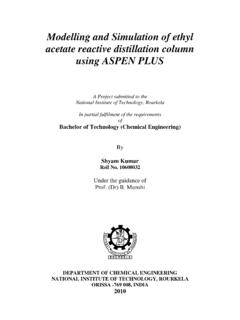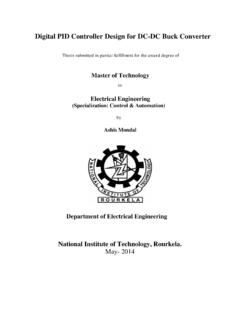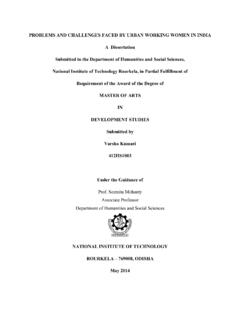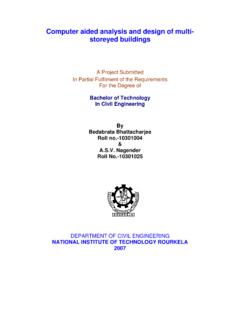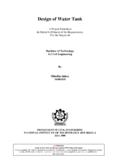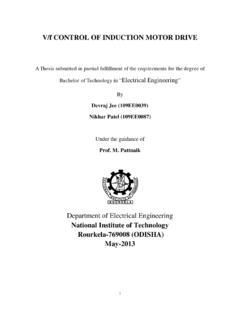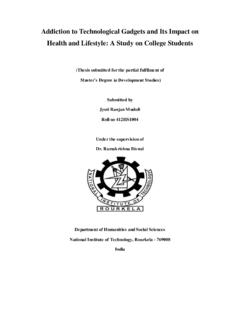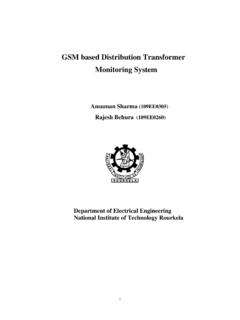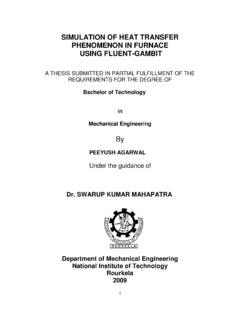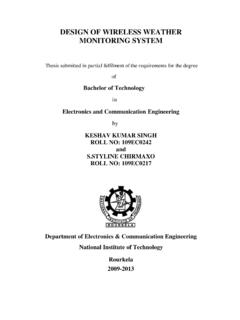Transcription of STUDY OF MAXIMUM POWER POINT TRACKING (MPPT) …
1 1 STUDY OF MAXIMUM POWER POINT TRACKING (MPPT) TECHNIQUES IN A solar PHOTOVOLTAIC ARRAY A PROJECT SUBMITTED IN PARTIAL FULFILLMENT OF THE REQUIREMENT FOR THE DEGREE OF Bachelor of Technology in Electrical Engineering By Arjav Harjai (107EE049) Abhishek Bhardwaj (107EE055) Mrutyunjaya Sandhibigraha (107EE056) Department of Electrical Engineering national Institute of Technology Rourkela-769008, Orissa 2 STUDY OF MAXIMUM POWER POINT TRACKING (MPPT) TECHNIQUES IN A solar PHOTOVOLTAIC ARRAY A PROJECT SUBMITTED IN PARTIAL FULFILLMENT OF THE REQUIREMENT FOR THE DEGREE OF Bachelor of Technology in Electrical Engineering By Arjav Harjai (107EE049) Abhishek Bhardwaj (107EE055) Mrutyunjaya Sandhibigraha (107EE056) Department of Electrical Engineering national Institute of Technology Rourkela-769008, Orissa 3 ACKNOWLEDGEMENT We would like to express our gratitude towards all the people who have contributed their precious time and efforts to help us in completing this project, without whom it would not have been possible for us to understand and analyze the project.
2 We would like to thank Prof. Susovon Samanta, Department of Electrical Engineering, our Project Supervisor, for his guidance, support, motivation and encouragement throughout the period this work was carried out. His readiness for consultation at all times, his educative comments, his concern and assistance have been invaluable. We are also grateful to Dr. Subudhi, Professor and Head, Department of Electrical Engineering, for providing the necessary facilities in the department. Last, but not the least, we would like to thank our dear friend Subhakanta Ranasingh for his constant help and support throughout the length of the project.
3 Arjav Harjai (107EE049) Abhishek Bhardwaj (107EE055) Mrutyunjaya Sandhibigraha (107EE056) 4 CERTIFICATE This is to certify that the Project entitled STUDY OF MAXIMUM POWER POINT TRACKING (MPPT) TECHNIQUES IN A solar PHOTOVOLTAIC ARRAY submitted by Arjav Harjai, Abhishek Bhardwaj and Mrutyunjaya Sandhibigraha in partial fulfillment of the requirements for the award of Bachelor of Technology Degree in Electrical Engineering at national Institute of Technology, Rourkela (Deemed University), is an authentic work carried out by them under my supervision and guidance. Date: (Prof. S. Samanta) Place: Rourkela Department of Electrical Engineering NIT, Rourkela 5 ABSTRACT The need for renewable energy sources is on the rise because of the acute energy crisis in the world today.
4 India plans to produce 20 Gigawatts solar POWER by the year 2020, whereas we have only realized less than half a Gigawatt of our potential as of March 2010. solar energy is a vital untapped resource in a tropical country like ours. The main hindrance for the penetration and reach of solar PV systems is their low efficiency and high capital cost. In this thesis, we examine a schematic to extract MAXIMUM obtainable solar POWER from a PV module and use the energy for a DC application. This project investigates in detail the concept of MAXIMUM POWER POINT TRACKING (MPPT) which significantly increases the efficiency of the solar photovoltaic system.
5 6 CONTENTS 1 Introduction 11 The need for Renewable Energy 11 Different sources of Renewable Energy 11 Wind POWER 11 solar POWER 12 Small hydropower 12 Biomass 12 Geothermal 12 Renewable Energy trends across the globe 13 2 Literature Review 15 3 Standalone Photovoltaic System Components 17 Photovoltaic cell 17 PV module 17 PV modeling 17 Boost Converter 21 Mode 1 operation of the Boost Converter 22 Mode 2 operation of the Boost Converter 23 4 MAXIMUM POWER POINT TRACKING Algorithms 25 An overview of MAXIMUM POWER POINT TRACKING 25 Different MPPT techniques 25 Perturb & Observe 26 Incremental Conductance 26 Fractional open circuit voltage 27 Fractional short circuit current 28 Fuzzy Logic Control 28 Neural Network 28 Perturb & Observe Algorithm 30 7 Limitations of Perturb & Observe algorithm 32 Implementation of MPPT using a boost converter 33 5 Modeling of standalone PV system 34 solar panel 34 MPPT Interfacing 36 Boost Converter 38 PI Controller 38 6 Results 40 Case 1: Running the system without MPPT 40 Case 2: Running the system with MPPT 43 7 Conclusion 47 8 References 48 8 LIST OF FIGURES Figure : Global energy consumption in the year 2008 [7] 13 Figure : Single diode model of a PV cell 18 Figure : I-V characteristics of a solar panel [13] 19 Figure.
6 P-V characteristics curve of photovoltaic cell [13] 20 Figure : Circuit diagram of a Boost Converter 21 Figure : Mode 1 operation of Boost Converter 22 Figure : Mode 2 operation of Boost Converter 23 Figure : Waveforms for a Boost Converter [14] 24 Figure : solar panel characteristics showing MPP and operating points A and B [16] 30 Figure : Flowchart of Perturb & Observe algorithm 31 Figure : Curve showing wrong TRACKING of MPP by P&O algorithm under rapidly varying irradiance [16] 32 Figure : Requisite implementation for MPPT system 33 Figure : Masked block diagram of the modeled solar PV panel 34 Figure : Unmasked block diagram of the modeled solar PV panel 35 Figure : Irradiation signal (Watt per sq.)
7 Cm. versus time) 36 Figure : SIMULINK Model of MPPT system using P&O algorithm 37 Figure : Plot of Output voltage of PV panel v/s time without MPPT 40 Figure : Plot of POWER output of PV panel v/s time without MPPT 40 Figure : Plot of Output Voltage at load side v/s time without MPPT 41 Figure : Plot of Output current at load side v/s time without MPPT 41 Figure : Plot of POWER obtained at load side v/s time without MPPT 42 Figure : Plot of PI Control gain v/s time without MPPT 42 Figure : Plot of Output voltage of PV panel v/s time with MPPT 43 Figure : Plot of POWER output of PV panel v/s time with MPPT 43 Figure : Plot of calculated MPPT Vref voltage v/s time with MPPT 44 Figure : Plot of Output Voltage at load side v/s time with MPPT 44 9 Figure : Plot of Output current at load side v/s time with MPPT 45 Figure : Plot of POWER obtained at load side v/s time with MPPT 45 Figure : Plot of PI Control gain v/s time with MPPT 46 10 LIST OF TABLES Table 1 : Characteristics of different MPPT techniques [15] 29 Table 2 : Different parameters of the standalone PV system 39 11 1 Introduction The need for Renewable Energy Renewable energy is the energy which comes from natural resources such as sunlight, wind, rain, tides and geothermal heat.
8 These resources are renewable and can be naturally replenished. Therefore, for all practical purposes, these resources can be considered to be inexhaustible, unlike dwindling conventional fossil fuels [1]. The global energy crunch has provided a renewed impetus to the growth and development of Clean and Renewable Energy sources. Clean Development Mechanisms (CDMs) [2] are being adopted by organizations all across the globe. Apart from the rapidly decreasing reserves of fossil fuels in the world, another major factor working against fossil fuels is the pollution associated with their combustion. Contrastingly, renewable energy sources are known to be much cleaner and produce energy without the harmful effects of pollution unlike their conventional counterparts.
9 Different sources of Renewable Energy Wind POWER Wind turbines can be used to harness the energy [3] available in airflows. Current day turbines range from around 600 kW to 5 MW [4] of rated POWER . Since the POWER output is a function of the cube of the wind speed, it increases rapidly with an increase in available wind velocity. Recent advancements have led to aerofoil wind turbines, which are more efficient due to a better aerodynamic structure. 12 solar POWER The tapping of solar energy owes its origins to the British astronomer John Herschel [5] who famously used a solar thermal collector box to cook food during an expedition to Africa.
10 solar energy can be utilized in two major ways. Firstly, the captured heat can be used as solar thermal energy, with applications in space heating. Another alternative is the conversion of incident solar radiation to electrical energy, which is the most usable form of energy. This can be achieved with the help of solar photovoltaic cells [6] or with concentrating solar POWER plants. Small hydropower Hydropower installations up to 10MW are considered as small hydropower and counted as renewable energy sources [7]. These involve converting the potential energy of water stored in dams into usable electrical energy through the use of water turbines. Run-of-the-river hydroelectricity aims to utilize the kinetic energy of water without the need of building reservoirs or dams.
